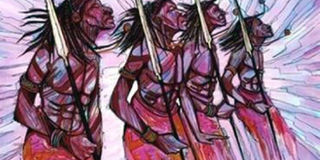Transforming lives through batik art

Some of Kibuuka’s art pieces. Courtesy photo.
What you need to know:
Kibuuka has been working with wax and dyes on fabric since 1975 and thus is a maestro in the modern batik art technique.
The versatility of wax and dyes reveals itself gradually on fabric as unique work of batik art. A path of discovery that lends itself to personal creativity and self-expression is how artist David Kibuuka describes batik.
Kibuuka has been working with wax and dyes on fabric since 1975 and thus is a maestro in the modern batik art technique.
“I do oils, acrylic, mixed media and modern batik. The main goal, when working with modern batik art, is to enjoy the medium and allow the versatility of wax and dyes to reveal itself gradually to you on fabric,” he says, adding that the technique is an effective strategy that is engaging and therapeutic to artists of all ages.
This, perhaps, explains why he has made it his passion to train others on the batik. “I have done school workshops. I want to empower people through art. I do workshops in high schools and in universities. I go to different countries around the world.
I want to link up with Non Governmental Organisations (NGOs) for sustainable products, especially for the youths. We can teach fashion designers to make nice fabrics, bags and clothes using batiks,” he says.
Kibuuka has worked with international organisations like UNICEF and rotary clubs. Now in his mid 50s, Kibuuka, who graduated from Ontario College of Art and Design in 1988 in Animation and Computer Graphics, has trained trainers in North America and students at Kyambogo and Makerere Univeristies, Lubowa International School of Uganda, schools in Mombasa, Tanzania and Kigali International School among other institutions. These are usually one-month-long workshops. “Some students invite me back to their countries to see their work.
Some are supplying designers in Toronto. I have turned them into entrepreneurs. I want to connect with NGOs to support unemployed individuals. I have a way of getting people from zero to a higher grade,” he says, adding, “This generation is about innovation. Bill Gates and Steve Jobs said this long time ago.”
Kibuuka believes disunity among artists is the biggest challenge preventing Ugandan artists from realising their full potential. “When united, we can have one voice. We can for instance have a declaration that 90 per cent of all portraits in government buildings should be by Ugandan artists. Some countries have such laws,” he argues.
He reveals that products such as table mats, lesus (body wrappers), lampshades, women’s bags, just about anything, can be done out of batik prints. His own art work is often accessed digitally. He has been online since 1998.
The artist spends most of his time travelling around the world to train, most recently in Rwanda. His mission is to encourage artists to network and become entrepreneurs through art.
His works
Price: Ranges from Shs35,000 to Shs1 million, depending on the size.
Where to buy: Acacia and Forest malls (House of J), Buganda Road (Twende Gallery), G and G at Mabirizi plaza and at Book Point first floor of the shopping village in Bugolobi




